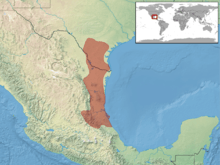Ficimia streckeri
| Ficimia streckeri | |
|---|---|
| Conservation status | |
| Scientific classification | |
| Kingdom: | Animalia |
| Phylum: | Chordata |
| Subphylum: | Vertebrata |
| Class: | Reptilia |
| Order: | Squamata |
| Suborder: | Serpentes |
| Family: | Colubridae |
| Subfamily: | Colubrinae |
| Genus: | Ficimia |
| Species: | F. streckeri |
| Binomial name | |
| Ficimia streckeri Taylor, 1931 | |
 | |
Ficimia streckeri, commonly known as the Mexican hooknose snake or Tamaulipan hooknose snake, is a small species of colubrid snake. It is endemic to northeastern Mexico and the adjacent southwestern United States.
Etymology
The specific name or epithet, streckeri, is in honor of the American naturalist John Kern Strecker, Jr.[1]
Geographic range
It is found primarily in the Mexican states of Nuevo León, Tamaulipas, San Luis Potosí and Puebla, but its range extends as far north as the United States, in southern Texas.
Description
The Mexican hooknose snakes is usually 5 to 11 in (13 to 28 cm) in total length. H.M. Smith and Brodie (1982) report a maximum total length of 47.9 cm (almost 19 inches).[2]
It is typically brown or gray in color, with as many as 60 brown or brown-green blotches down the back, which are elongated to almost appear as stripes. Its underside is white or cream-colored.
Its most distinctive feature is an upturned snout, much like hognose snakes, which gives it its common name. However, unlike hognose snakes, Mexican hooknose snakes have smooth dorsal scales. Also distinctive is the arrangement of the head shields. There are no internasals, and the rostral separates the prefrontals and contacts the frontal.[3]
The smooth dorsal scales are arranged in 17 rows at midbody. Ventrals 126-155, subcaudals 28-41.[2]
Behavior
The Mexican hooknose snake is mostly nocturnal, and is a burrower.[4][5] It is fairly slow-moving and harmless to humans.
Diet
Its diet consists primarily of spiders and centipedes.
Habitat
They inhabit woodlands along the Rio Grande river plain, near natural and man-made sources of water.
Defense
Its primary form of defense is making a popping sound by expanding its cloaca when harassed or handled.
Reproduction
Mexican hooknose snakes are oviparous.
References
- ↑ Beltz, Ellin. 2006. Scientific and Common Names of the Reptiles and Amphibians of North America - Explained. www.ebeltz.net/herps/biogappx.html#S.
- ↑ 2.0 2.1 Smith, H.M., and E.D. Brodie, Jr. 1982. Reptiles of North America: A Guide to Field Identification. Golden Press. New York. 240 pp. ISBN 0-307-13666-3. (Ficimia streckeri, pp. 174-175.)
- ↑ Schmidt, K.P., and D.D. Davis. 1941. Field Book of Snakes of the United States and Canada. G.P. Putnam's Sons. New York. 365 pp. (Ficimia streckeri, p. 203.)
- ↑ Wright, A.H., and A.A. Wright. 1957. Handbook of Snakes of the United States and Canada. Comstock. Ithaca and London. 1,105 pp. (in 2 volumes) (Ficimia olivacea streckeri, pp. 279-282, Figure 86., Map 26.)
- ↑ Conant, R. 1975. A Field Guide to Reptiles and Amphibians of Eastern and Central North America, Second Edition. The Peterson Field Guide Series. Houghton Mifflin. Boston. 429 pp. (Ficimia streckeri, pp. 216-217 + Plate 33 + Map160.)
- Species Ficimia streckeri at The Reptile Database
Further reading
Taylor, E.H. 1931. Notes on Two Specimens of the Rare Snake Ficimia cana and the Description of a New Species of Ficimia from Texas. Copeia 1931 (1): 4-7.
External links
![]() Media related to Ficimia streckeri at Wikimedia Commons
Media related to Ficimia streckeri at Wikimedia Commons
![]() Data related to Ficimia streckeri at Wikispecies
Data related to Ficimia streckeri at Wikispecies
